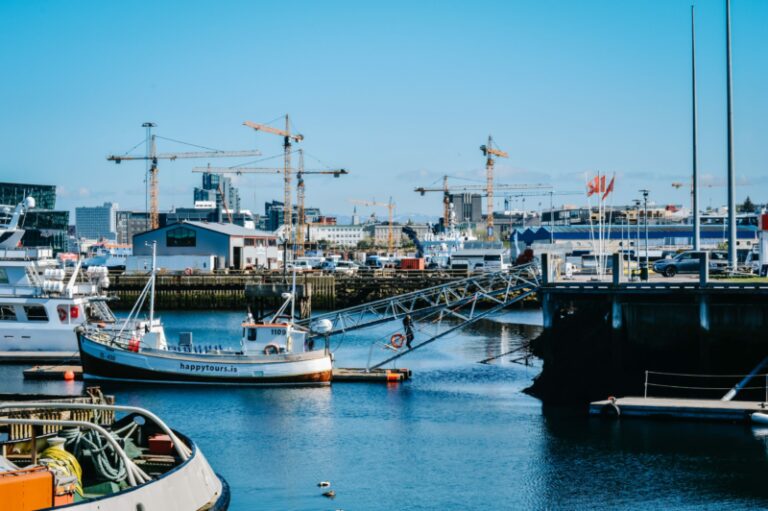What is the blue economy?

The term ‘blue economy’ broadly relates to a sustainable ocean economy – the economic activities associated with the ocean, seas and coastal regions – that allows resource use while preserving the health of the ocean ecosystem. However, there is no universally agreed definition.
Size of the ocean economy
The ocean economy comprises all economic activities related to the ocean, such as offshore oil and gas, marine equipment and construction, container shipping, shipbuilding and repair, cruise tourism, port activities and marine energy. It also includes the ocean’s natural assets and the ecosystem services it provides, from fisheries to carbon sequestration.
The growth of ocean-based economic activities has gathered pace over the past 50 years and the ocean economy is now estimated to be worth approximately US$1.5 trillion. This could increase to US$3 trillion by 2030, with significant further growth expected particularly in offshore wind, marine aquaculture and fish processing.
The primary focus of the ocean economy is on maximising economic benefits. This often leads to ecological degradation and resource depletion at the expense of marine ecosystems and the communities that depend on them.
From the ocean economy to the sustainable, ‘blue’ economy
To distinguish a future in which ocean-related economic activities are guided by sustainable considerations, new terms have been adopted. ‘Blue economy’ has become the most widely used term, although its conceptualisation differs across stakeholders and countries. In finance circles, the term has largely focused on the decarbonisation of existing ocean economy activities as the world transitions to net zero greenhouse gas emissions to meet the Paris Agreement temperature targets. Other definitions are wider, encompassing the sustainable use of resources for socioeconomic benefit, including supporting jobs and livelihoods, promoting poverty reduction, ‘stewardship’ of the ocean’s resources, and marine education and research. As a more ambitious and holistic view is increasingly taken of the ocean economy that integrates economic growth with environmental sustainability and social equity, alternative terms are being used in place of ‘blue economy’, such as ‘sustainable ocean economy’, ‘sustainable blue economy’ and more recently the ‘regenerative blue economy’. Figure 1 shows progression of this concept.
Figure 1. A classification of economic activities in the ocean

Source: Almeida and Reitmeier (2024)
One of the 17 Sustainable Development Goals (SDGs) is dedicated to the ocean: number 14, ‘Life Below Water’ aims to conserve and sustainably use the ocean, seas and marine resources. It sets out seven targets for a sustainable ocean economy by 2030. So far, progress towards reaching these goals has been limited. There have been some small improvements in the sustainability of fisheries and an expansion of Marine Protected Areas (MPAs), but these cover only around 7.5% of the oceans. It has been estimated that an additional investment of US$8–11 billion is required to achieve the objective of creating MPAs that cover 30% of the ocean by 2030.
Governments and companies are also taking an increasing interest in nature-based solutions to climate change provided by the ocean. These include carbon sequestration and protecting coastlines from the physical impacts of climate change. However, only 9% of total investments in nature-based solutions are in the marine environment.
How is the ocean and its economic activity governed?
The ocean is a vast space in which a range of stakeholders are active, yet it operates as a highly interconnected ecosystem. The deterioration of environmental resources in one location can have far-reaching detrimental impacts on other ecosystems and communities; therefore, strong governance mechanisms are vital. However, ocean governance is complex and potentially difficult to implement and is fragmented as a result. There are various UN bodies responsible for regulating different spatial zones and ocean economy sectors. These are supported by regional, national and sectoral institutions. But current governance frameworks face significant challenges in establishing clear responsibilities and enforcing rules to adequately address issues such as overfishing, habitat destruction, pollution and climate change impacts.
Coastal nations have exclusive rights to control activities, apply laws and use resources within their Territorial Sea: the area extending 12 nautical miles into the sea. Extending up to 200 nautical miles from coastlines is the Exclusive Economic Zone (EEZ), in which nations can conserve, exploit and manage the living and non-living resources present in the water, seabed and subsurface. The remaining area is called the High Seas (or ‘open ocean’) and accounts for about 65% of the ocean. In March 2023, an historic agreement was reached at the United Nations for a High Seas Treaty which aims to place 30% of the world’s ocean into MPAs to protect wildlife and ensure equal access to marine genetic resources. It also allocates funds to marine conservation and will foster the development of clear rules on how to conduct environmental impact assessments for human activities in the high seas. The Treaty will establish a Conference of the Parties (CoP) for the ocean, similar to the climate and biodiversity COPs.
Other international agreements on ocean governance that impact the blue economy include: the United Nations Convention on the Law of the Sea (UNCLOS), which sets out the legal regime for activities on the oceans and seas along with State responsibilities; the Port States Measures Agreement (PSMA), which seeks to prevent, deter and illuminate Illegal, Unreported and Unregulated (IUU) fishing through management at Port States; Guidelines for Small Scale Fisheries; and IMO 2023, the International Maritime Organization’s regulations on global shipping.
What risks are presented by the blue economy?
Transitioning to a sustainable blue economy introduces challenges that can have financial implications, for example through regulatory changes, technological innovations, shifting consumer preferences and reputational considerations. This may include removing subsidies that encourage overfishing, or strengthening environmental regulations, including the designation of new marine protected areas in line with the global target of conserving at least 30% of land, waters and seas by 2030. International agreements may also result in additional costs and regulatory burdens for specific industries that currently utilise marine resources for free.
However, financial and economic policymakers need to assess these transition risks alongside physical risks that could worsen if we do not progress with the transition to a sustainable economy: over US$8 trillion in assets are potentially at risk from extreme weather events, sea-level rise and other threats related to climate change. Shifting weather patterns, exacerbated by phenomena like El Niño, can further amplify risks, particularly for less-prepared regions.
Proactive recognition and management of these risks is required to avoid systemic disruption to the financial system.
This Explainer is based on an original written by Darian McBain and was updated by Lea Reitmeier and Georgina Kyriacou in December 2024.

